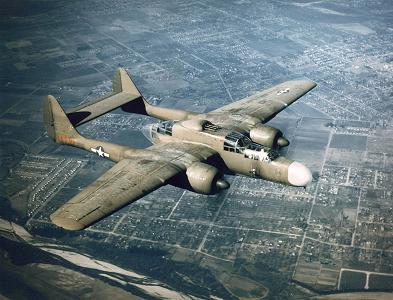![]() The Pacific War Online Encyclopedia
The Pacific War Online Encyclopedia
|
| Previous: P-51 Mustang, U.S. Fighter | Table of Contents | Next: P-66 Vanguard, U.S. Fighter |

U.S. Air Force. Via Wikipedia Commons.
Northrop P-61A Black Widow
| Crew | 3 | ||
| Dimensions | 66' by
48'11" by
14'8" 20.12m by 14.91m by 4.47m |
||
| Wing area | 664 square feet 61.7 square meters |
||
| Weight | 24,000-32,400 lbs 10,900-14,700 kg |
||
| Maximum speed | 372 mph (599 km/h) at 17,600
feet (5360 meters) 333 mph (536 km/h) at sea level |
||
| Cruise speed | 200 mph 322 km/h |
||
| Landing speed | 85 mph 137 km/h |
||
| Climb rate | 39 feet per second 11.9 meters per second |
||
| Service ceiling | 33,700 feet 10,300 meters |
||
| Power plant | 2 2000 hp (1491 kW) Pratt and Whitney R-2800-10 Double Wasp 18-cylinder two-row radial engines | ||
| Armament | 4 20mm M-2 fixed
belly cannon 1 electric remote control dorsal turret with 4 0.50 machine guns |
||
| Range | 1208 miles 1944 km |
||
| Fuel | 640 gallons 2400 liters |
||
| Sensors | SCR-720 airborne interception radar | ||
| Production | 941 of all types from 5/44 at Northrop Air Incorporated, Hawthorne, CA: | ||
| 15 | prototypes |
|
|
| 200 | P-61A | ||
| 450 | P-61B | ||
| 41 | P-61C | ||
| Variants |
The P-61B added pylons for four 250 gallon (946 liter) drop tanks or four 1600 lb (726 kg) bombs. Some of the early production aircraft lacked the dorsal turret. The P-61C had R-2800-73 engines. About 16 were converted to unarmed weather reconnaissance P-61G. |
||
The P-61 was the first aircraft ever
designed from the
ground up as a night fighter, using the experience of the earliest
radar-equipped RAF
night fighters. It carried the new SCR-720
airborne
interception radar in its nose, and its main armament sat well back on
its
central nacelle. It had a large fuel capacity and was fast and agile
for its size. The aircraft derived its nickname, the Black Widow (a
poisonous North American spider), from its all-black finish.
The dorsal turret was remotely controlled and
could be aimed from the front or rear positions of the aircraft and
fired by the pilot. This
turret was omitted on some of the early P-61B
models because it created turret buffet. This problem was solved
halfway through the P-61B production run and the turret was restored.
The pylons added to the P-61B allowed it to carry as heavy a bomb load
as some medium bombers.
Though the aircraft was introduced quite late in
the war, due in part to difficulties working the bugs out of the
SCR-720 installation, there were several P-61 aces
in the
Pacific. 56% of P-61 crews were deployed to the Pacific or Far East.
References
The Pacific War Online Encyclopedia © 2007, 2009 by Kent G. Budge. Index